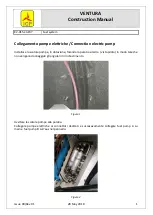
24
USER MANUAL
GRAVITY X pressure
EN REV.V01 - 2020
8
RAPID DESCENT_
Should a fast descent be necessary due to special weather conditions such as
thunderstorms, a weather front, extreme winds or other dangers and hazardous situations
occur, the following options are available:
PAY ATTENTION_
The manoeuvres described for quick/ fast descent put an extra
amount of strain and pressure on your paraglider and should therefore only be used for
training or used in emergency situations.
8.1.1
„Big Ears“
Both designated outer A2-risers (grab at or above the quick links) are being pulled down
simultaneously for 15-20 cm to fold in the wing tips. The brake toggles are to be held in
hand together with the pulled down a-lines. for additional stability and for an increased sink
rate
the speed system should be actuated. The glider remains fully steerable by weight shifting
and descents at an elevated sink rate (4-7 m/sec, depending on how many cells are folded
in) straight forward. Once the a-risers are released, the folded wingtips re-inflate
automatically, if not you may pump the brakes gently. due to the high wing load “big
earing” is a very stable flight condition even in turbulent conditions. Please be aware that
you reduce the trim speed during “big ears”, but this can be compensated by applying the
speed bar. “Big ears” in combination with weight shifting in order to get the spiral dive, will
achieve the highest sink rate. This decent method is often taught in SIV training. Be mindful
that this exposes the glider to extreme loads, should one need to use this manoeuvre we
recommend an equipment inspection afterwards.
8.1.2
B-Stall
Another very efficient method is the B-stall. The B-line stall is generally considered the
easiest descent aid. But be careful, if it is executed incorrectly, it is anything but harmless!
The B-line stall allows you to sink from 6 to over 9 m /s. Orientate yourself on your
whereabouts and the airspace below and behind you before you start a B-Stall. Make sure
you have enough height. To start, take the two B-lines over the line locks. With the brakes
always in your hands, pull the B-risers down evenly and symmetrically from shoulder to
chest level.
Remain in this position. Your sail will come to a halt, the glider will partially empty and
stabilize over your head. The canopy tilts back a little, which should under no circumstances
entice you to release the B-lines again. The result would be heavy advance and commute.
Only when the sail has stabilized over your head can the diversion begin. To do this, bring
the B-risers back quickly and symmetrically to their starting position. We recommend that
you do not just let go of the straps, as this results in enormous mechanical forces on the








































